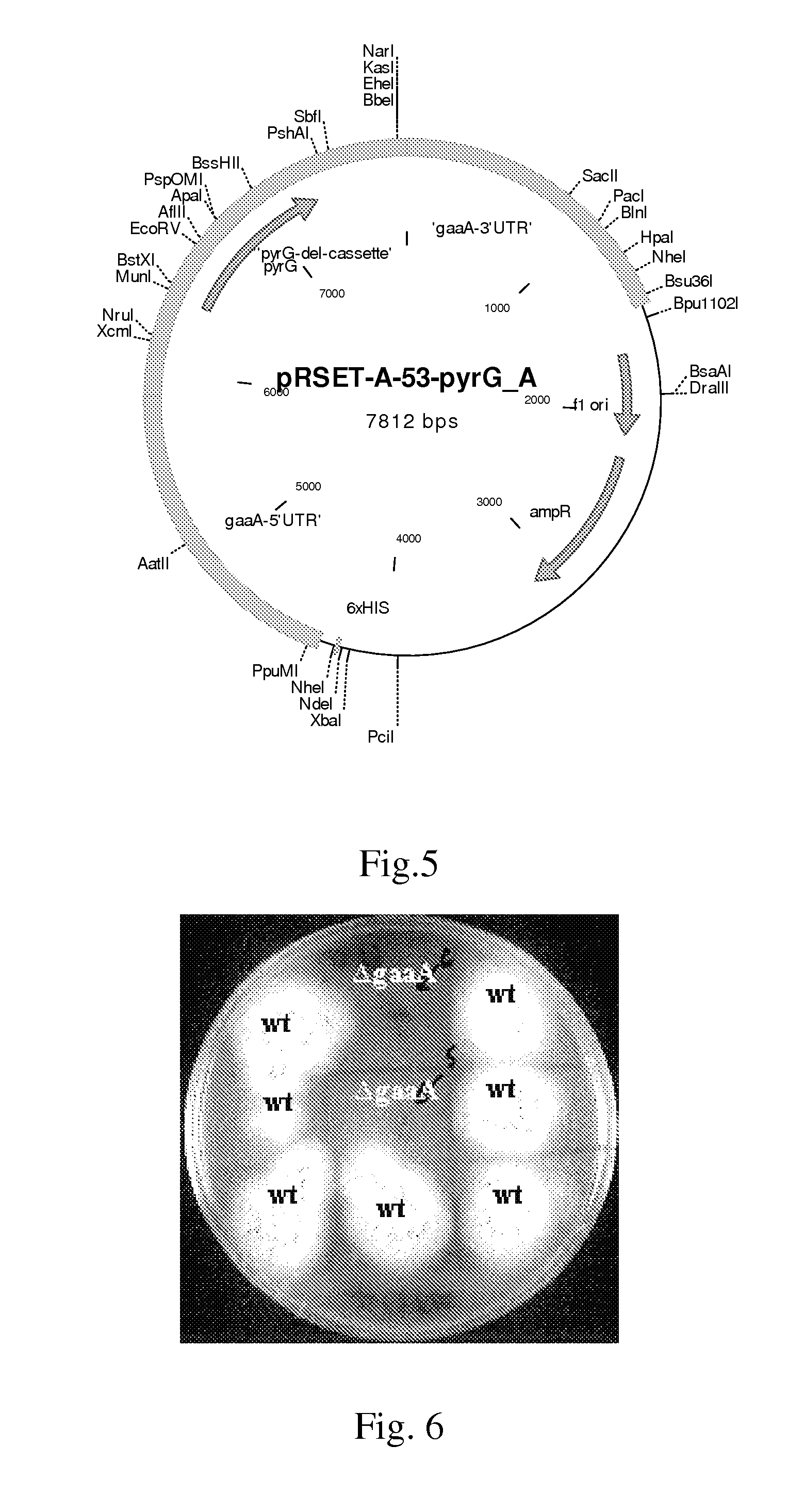Conversion of hexuronic acid to hexaric acid
a technology of hexaric acid and hexuronic acid, which is applied in the field of microbial host strains for converting hexaric acid to hexaric acid, can solve the problem of not being able to use these bacteria, and achieve the effect of reducing the amount of hexaric acid released to the environmen
- Summary
- Abstract
- Description
- Claims
- Application Information
AI Technical Summary
Benefits of technology
Problems solved by technology
Method used
Image
Examples
example 1
Cloning and Expression of the D-galacturonic Acid Dehydrogenase in a Heterologous Host
[0078]A commercial culture collection strain CS58 of Agrobacterium tumefaciens (Rhizobium radiobacter) was grown in a minimal medium containing D-galacturonic acid. The cells were lysed by sonication and the protein extract was then bound to a DEAE column and eluted with a linear salt gradient. The fractions were tested for D-galacturonic acid dehydrogenase activity using D-galacturonic acid and NAD reaction as the substrates by measuring the NADH production by following the absorption at 340 nm. The active fractions were concentrated and applied to a non-denaturating PAGE. After separation the active fraction was identified using zymogram staining.
[0079]The active fractions were identified and separated on an SDS-PAGE. A 32 kDa protein band was identified as the D-galacturonic acid dehydrogenase. The protein band was cut from the gel, digested with trypsin and the resulting peptides were analyzed ...
example 2
Characterization of the Enzyme Activity
[0081]The S. cerevisiae strain resulting from the Example 1 was then disintegrated by vortexing with glass beads and the yeast extract analysed for D-galacturonic acid dehydrogenase activity. In a control experiment a similar strain but with an empty plasmid was used. To assay the D-galacturonic acid dehydrogenase activity the crude cell extract was mixed with 0.5 mM NAD and 4 mM D-galacturonic acid in a 50 mM Tris pH 7.5 buffer containing 0.5 mM MgCl2. The activity was 0.12 units per mg of extracted protein. One unit is the activity that forms 1 μmol of product per minute. In the control strain no activity could be detected.
example 3
Characterization of the Purified Histidine-Tagged D-galacturonic Acid Dehydrogenase
[0082]The D-galacturonic acid dehydrogenase with a histidine-tag at the N-terminal end was produced in a similar manner as in the Example 1, except that the histidine-tag was introduced by PCR. To introduce the histidine tag the following primers were used 5′-CCGGAATTCACCATGCACCACCATCACCATCACATGGCGATGAAACGGCTTCTTG-3′ (SEQ ID NO:5) in sense direction and 5′-GGCTTGGGATCCCGCTGATCATTCAGCTC-3′ (SEQ ID NO:6) in anti-sense.
[0083]After the expression of the histidine-tagged protein in S. cerevisiae as described in the Example 1 the activity was measured as described in the Example 2. The histidine tagged protein exhibited the same activity as the non-tagged protein in the yeast extract. The histidine-tagged D-galacturonic acid dehydrogenase was then purified using a Ni-NTA-agarose (Qiagen) according to the instructions of the manufacturer. The purified enzyme gave a single band in an SDS PAGE.
[0084]The protei...
PUM
| Property | Measurement | Unit |
|---|---|---|
| D-galacturonic acid dehydrogenase activity | aaaaa | aaaaa |
| acid | aaaaa | aaaaa |
| affinity | aaaaa | aaaaa |
Abstract
Description
Claims
Application Information
 Login to View More
Login to View More - R&D
- Intellectual Property
- Life Sciences
- Materials
- Tech Scout
- Unparalleled Data Quality
- Higher Quality Content
- 60% Fewer Hallucinations
Browse by: Latest US Patents, China's latest patents, Technical Efficacy Thesaurus, Application Domain, Technology Topic, Popular Technical Reports.
© 2025 PatSnap. All rights reserved.Legal|Privacy policy|Modern Slavery Act Transparency Statement|Sitemap|About US| Contact US: help@patsnap.com



